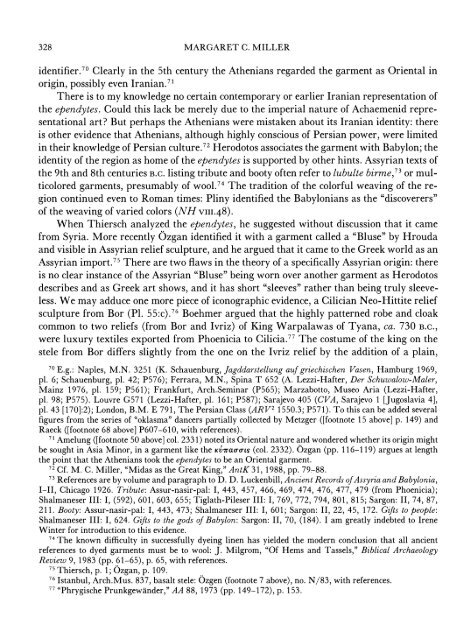the ependytes in classical athens - The American School of ...
the ependytes in classical athens - The American School of ...
the ependytes in classical athens - The American School of ...
Create successful ePaper yourself
Turn your PDF publications into a flip-book with our unique Google optimized e-Paper software.
328 MARGARET C. MILLER<br />
identifier.70 Clearly <strong>in</strong> <strong>the</strong> 5th century <strong>the</strong> A<strong>the</strong>nians regarded <strong>the</strong> garment as Oriental <strong>in</strong><br />
orig<strong>in</strong>, possibly even Iranian.7I<br />
<strong>The</strong>re is to my knowledge no certa<strong>in</strong> contemporary or earlier Iranian representation <strong>of</strong><br />
<strong>the</strong> <strong>ependytes</strong>. Could this lack be merely due to <strong>the</strong> imperial nature <strong>of</strong> Achaemenid representational<br />
art? But perhaps <strong>the</strong> A<strong>the</strong>nians were mistaken about its Iranian identity: <strong>the</strong>re<br />
is o<strong>the</strong>r evidence that A<strong>the</strong>nians, although highly conscious <strong>of</strong> Persian power, were limited<br />
<strong>in</strong> <strong>the</strong>ir knowledge <strong>of</strong> Persian culture.72 Herodotos associates <strong>the</strong> garment with Babylon; <strong>the</strong><br />
identity <strong>of</strong> <strong>the</strong> region as home <strong>of</strong> <strong>the</strong> <strong>ependytes</strong> is supported by o<strong>the</strong>r h<strong>in</strong>ts. Assyrian texts <strong>of</strong><br />
<strong>the</strong> 9th and 8th centuries B.C. list<strong>in</strong>g tribute and booty <strong>of</strong>ten refer to lubulte birme,73 or multicolored<br />
garments, presumably <strong>of</strong> wool.74 <strong>The</strong> tradition <strong>of</strong> <strong>the</strong> colorful weav<strong>in</strong>g <strong>of</strong> <strong>the</strong> region<br />
cont<strong>in</strong>ued even to Roman times: Pl<strong>in</strong>y identified <strong>the</strong> Babylonians as <strong>the</strong> "discoverers"<br />
<strong>of</strong> <strong>the</strong> weav<strong>in</strong>g <strong>of</strong> varied colors (NH v1II.48).<br />
When Thiersch analyzed <strong>the</strong> <strong>ependytes</strong>, he suggested without discussion that it came<br />
from Syria. More recently Ozgan identified it with a garment called a "Bluse" by Hrouda<br />
and visible <strong>in</strong> Assyrian relief sculpture, and he argued that it came to <strong>the</strong> Greek world as an<br />
Assyrian import.75 <strong>The</strong>re are two flaws <strong>in</strong> <strong>the</strong> <strong>the</strong>ory <strong>of</strong> a specifically Assyrian orig<strong>in</strong>: <strong>the</strong>re<br />
is no clear <strong>in</strong>stance <strong>of</strong> <strong>the</strong> Assyrian "Bluse" be<strong>in</strong>g worn over ano<strong>the</strong>r garment as Herodotos<br />
describes and as Greek art shows, and it has short "sleeves" ra<strong>the</strong>r than be<strong>in</strong>g truly sleeveless.<br />
We may adduce one more piece <strong>of</strong> iconographic evidence, a Cilician Neo-Hittite relief<br />
sculpture from Bor (P1. 55:c).76 Boehmer argued that <strong>the</strong> highly patterned robe and cloak<br />
common to two reliefs (from Bor and Ivriz) <strong>of</strong> K<strong>in</strong>g Warpalawas <strong>of</strong> Tyana, ca. 730 B.C.,<br />
were luxury textiles exported from Phoenicia to Cilicia.77 <strong>The</strong> costume <strong>of</strong> <strong>the</strong> k<strong>in</strong>g on <strong>the</strong><br />
stele from Bor differs slightly from <strong>the</strong> one on <strong>the</strong> Ivriz relief by <strong>the</strong> addition <strong>of</strong> a pla<strong>in</strong>,<br />
70 E.g.: Naples, M.N. 3251 (K. Schauenburg, Jagddarstellung auf griechischen Vasen, Hamburg 1969,<br />
pl. 6; Schauenburg, pl. 42; P576); Ferrara, M.N., Sp<strong>in</strong>a T 652 (A. Lezzi-Hafter, Der Schuwalow-Maler,<br />
Ma<strong>in</strong>z 1976, pl. 159; P561); Frankfurt, Arch.Sem<strong>in</strong>ar (P565); Marzabotto, Museo Aria (Lezzi-Hafter,<br />
pl. 98; P575). Louvre G571 (Lezzi-Hafter, pl. 161; P587); Sarajevo 405 (CVA, Sarajevo 1 [Jugoslavia 4],<br />
pl. 43 [170]:2); London, B.M. E 791, <strong>The</strong> Persian Class (ARV2 1550.3; P571). To this can be added several<br />
figures from <strong>the</strong> series <strong>of</strong> "oklasma" dancers partially collected by Metzger ([footnote 15 above] p. 149) and<br />
Raeck ([footnote 68 above] P607-610, with references).<br />
71 Amelung ([footnote 50 above] col. 2331) noted its Oriental -nature and wondered whe<strong>the</strong>r its orig<strong>in</strong> might<br />
be sought <strong>in</strong> Asia M<strong>in</strong>or, <strong>in</strong> a garment like <strong>the</strong> Kv7raatLq (col. 2332). Ozgan (pp. 116-119) argues at length<br />
<strong>the</strong> po<strong>in</strong>t that <strong>the</strong> A<strong>the</strong>nians took <strong>the</strong> <strong>ependytes</strong> to be an Oriental garment.<br />
72 Cf. M. C. Miller, "Midas as <strong>the</strong> Great K<strong>in</strong>g," AntK 31, 1988, pp. 79-88.<br />
73 References are by volume and paragraph to D. D. Luckenbill, Ancient Records <strong>of</strong> Assyria and Babylonia,<br />
I-II, Chicago 1926. Tribute: Assur-nasir-pal: I, 443, 457, 466, 469, 474, 476, 477, 479 (from Phoenicia);<br />
Shalmaneser III: I, (592), 601, 603, 655; Tiglath-Pileser III: I, 769, 772, 794, 801, 815; Sargon: II, 74, 87,<br />
211. Booty: Assur-nasir-pal: I, 443, 473; Shalmaneser III: I, 601; Sargon: II, 22, 45, 172. Gifts to people:<br />
Shalmaneser III: I, 624. Gifts to <strong>the</strong> gods <strong>of</strong> Babylon: Sargon: II, 70, (184). I am greatly <strong>in</strong>debted to Irene<br />
W<strong>in</strong>ter for <strong>in</strong>troduction to this evidence.<br />
7 <strong>The</strong> known difficulty <strong>in</strong> successfully dye<strong>in</strong>g l<strong>in</strong>en has yielded <strong>the</strong> modern conclusion that all ancient<br />
references to dyed garments must be to wool: J. Milgrom, "Of Hems and Tassels," Biblical Archaeology<br />
Review 9, 1983 (pp. 61-65), p. 65, with references.<br />
75 Thiersch, p. 1; Ozgan, p. 109.<br />
76 Istanbul, Arch.Mus. 837, basalt stele: Ozgen (footnote 7 above), no. N/83, with references.<br />
77 "Phrygische Prunkgewander," AA 88, 1973 (pp. 149-172), p. 153.

















